KIA Optima 2006 2.G Owner's Guide
Manufacturer: KIA, Model Year: 2006, Model line: Optima, Model: KIA Optima 2006 2.GPages: 225, PDF Size: 3.77 MB
Page 31 of 225
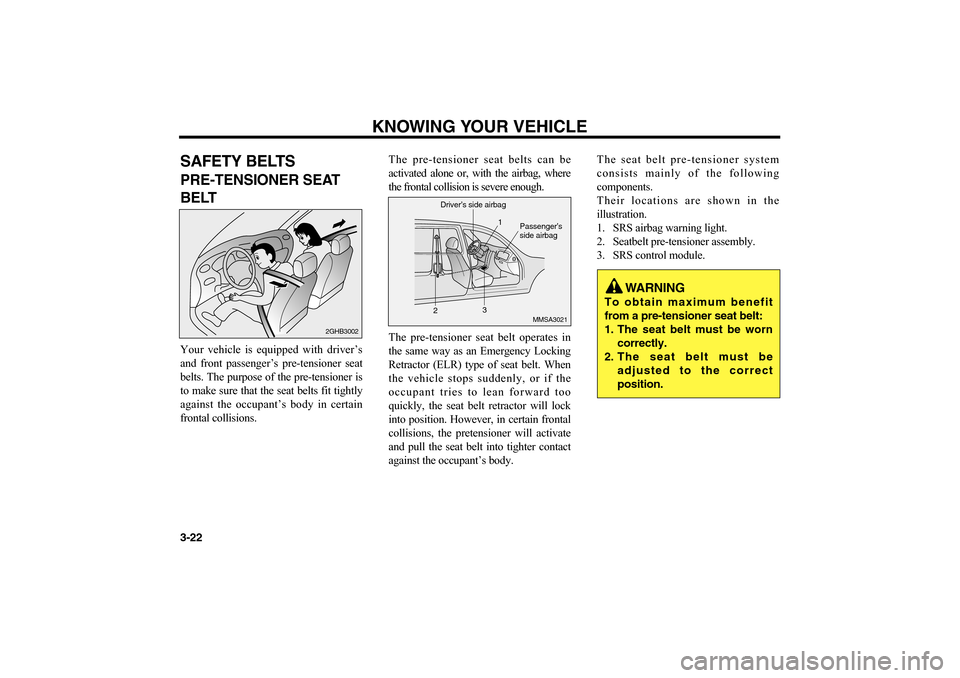
KNOWING YOUR VEHICLE
3-22SAFETY BELTSPRE-TENSIONER SEAT
BELTYour vehicle is equipped with driver’s
and front passenger’s pre-tensioner seat
belts. The purpose of the pre-tensioner is
to make sure that the seat belts fit tightly
against the occupant’s body in certain
frontal collisions.The pre-tensioner seat belts can be
activated alone or, with the airbag, where
the frontal collision is severe enough.
The pre-tensioner seat belt operates in
the same way as an Emergency Locking
Retractor (ELR) type of seat belt. When
the vehicle stops suddenly, or if the
occupant tries to lean forward too
quickly, the seat belt retractor will lock
into position. However, in certain frontal
collisions, the pretensioner will activate
and pull the seat belt into tighter contact
against the occupant’s body.The seat belt pre-tensioner system
consists mainly of the following
components.
Their locations are shown in the
illustration.
1. SRS airbag warning light.
2. Seatbelt pre-tensioner assembly.
3. SRS control module.
2GHB3002
MMSA3021
Driver’s side airbag
21
3Passenger’s
side airbag
WARNING
To obtain maximum benefit
from a pre-tensioner seat belt:
1. The seat belt must be worn
correctly.
2. The seat belt must be
adjusted to the correct
position.
MS-CNA-Eng 3.QXD 7/25/2005 5:17 PM Page 22
Page 32 of 225
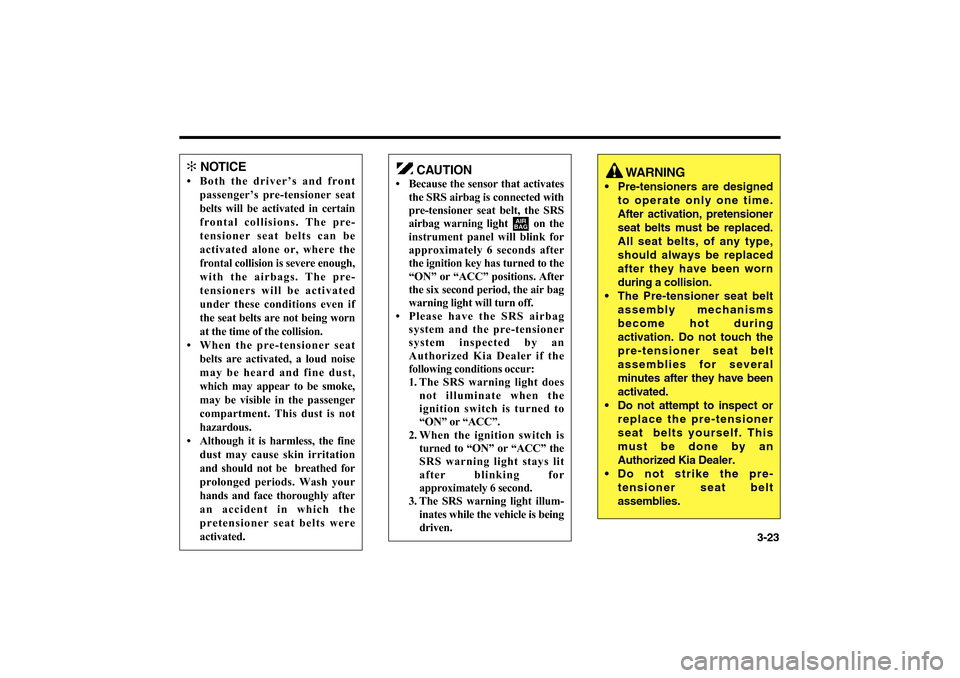
3-23
✻
NOTICE
• Both the driver’s and front
passenger’s pre-tensioner seat
belts will be activated in certain
frontal collisions. The pre-
tensioner seat belts can be
activated alone or, where the
frontal collision is severe enough,
with the airbags. The pre-
tensioners will be activated
under these conditions even if
the seat belts are not being worn
at the time of the collision.
• When the pre-tensioner seat
belts are activated, a loud noise
may be heard and fine dust,
which may appear to be smoke,
may be visible in the passenger
compartment. This dust is not
hazardous.
• Although it is harmless, the fine
dust may cause skin irritation
and should not be breathed for
prolonged periods. Wash your
hands and face thoroughly after
an accident in which the
pretensioner seat belts were
activated.
CAUTION
• Because the sensor that activates
the SRS airbag is connected with
pre-tensioner seat belt, the SRS
airbag warning light on the
instrument panel will blink for
approximately 6 seconds after
the ignition key has turned to the
“ON” or “ACC” positions. After
the six second period, the air bag
warning light will turn off.
• Please have the SRS airbag
system and the pre-tensioner
system inspected by an
Authorized Kia Dealer if the
following conditions occur:
1. The SRS warning light does
not illuminate when the
ignition switch is turned to
“ON” or “ACC”.
2. When the ignition switch is
turned to “ON” or “ACC” the
SRS warning light stays lit
after blinking for
approximately 6 second.
3. The SRS warning light illum-
inates while the vehicle is being
driven.
AIR
BAG
WARNING
Pre-tensioners are designed
to operate only one time.
After activation, pretensioner
seat belts must be replaced.
All seat belts, of any type,
should always be replaced
after they have been worn
during a collision.
The Pre-tensioner seat belt
assembly mechanisms
become hot during
activation. Do not touch the
pre-tensioner seat belt
assemblies for several
minutes after they have been
activated.
Do not attempt to inspect or
replace the pre-tensioner
seat belts yourself. This
must be done by an
Authorized Kia Dealer.
Do not strike the pre-
tensioner seat belt
assemblies.
MS-CNA-Eng 3.QXD 7/25/2005 5:17 PM Page 23
Page 33 of 225
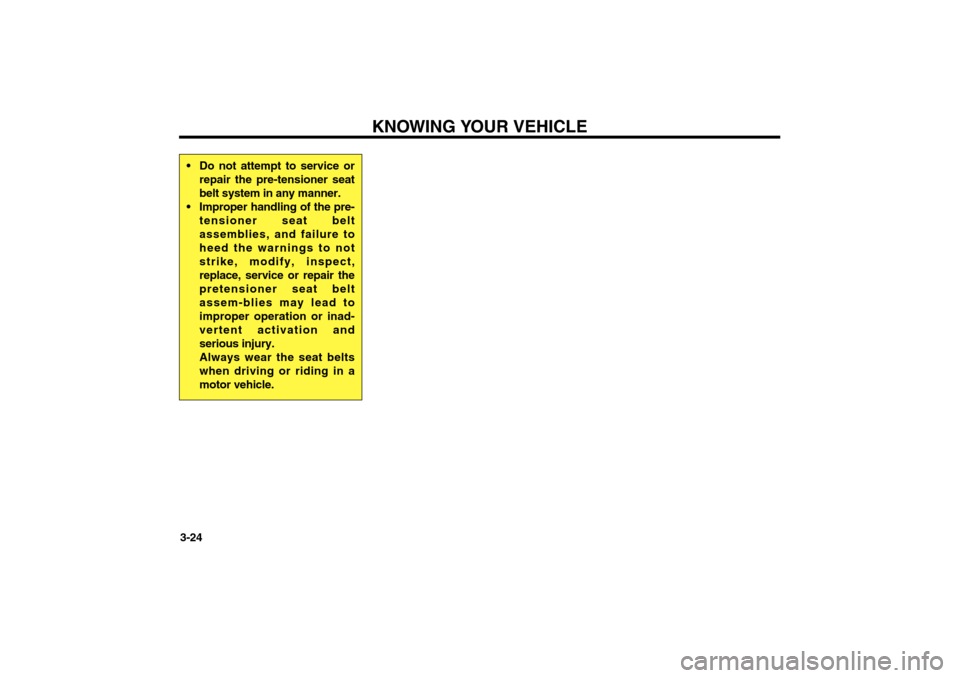
KNOWING YOUR VEHICLE
3-24 Do not attempt to service or
repair the pre-tensioner seat
belt system in any manner.
Improper handling of the pre-
tensioner seat belt
assemblies, and failure to
heed the warnings to not
strike, modify, inspect,
replace, service or repair the
pretensioner seat belt
assem-blies may lead to
improper operation or inad-
vertent activation and
serious injury.
Always wear the seat belts
when driving or riding in a
motor vehicle.
MS-CNA-Eng 3.QXD 7/25/2005 5:17 PM Page 24
Page 34 of 225

SAFETY BELT RESTRAINT
SYSTEMWe strongly recommend that the driver
and all passengers be properly restrained
at all times by using the safety belts
provided with the vehicle. Proper use of
the safety belts decreases the risk of
severe injury or death in accidents or
sudden stops.Safety belts provide the best restraint
when:
• The seatback is upright.
• The occupant is sitting upright (not
slouched).
• The lap belt portion of the safety belt
is snug and low on the hips.
• The shoulder belt portion of the
safety belt is snug against the chest.
• The knees are straight forward.
To help you remember to fasten your
safety belt, a warning light will flash and
a chime will sound.
See safety belt warning on page 4-22.
All seats have lap/shoulder belts.
The center rear seat has a lap/shoulder
belt.
Inertial locks in the safety belt retractors
allow all of the lap/shoulder safety belts
to remain unlocked during normal
vehicle operation.This allows the
occupants some freedom of movement
and increased comfort while using the
safety belts. If a force is applied to thevehicle, such as a strong stop, a sharp
turn, or a collision, the safety belt
retractors will automatically lock the
safety belts.
Since the inertial locks do not require a
collision in order to lock up, you may
become aware of the safety belts locking
while braking or going around sharp
corners.
The center rear seat safety belt does not
have an inertial lock so it is always in a
locked condition.
Whenever possible, use the center rear
seat position to install your child
restraint. The center rear seat is the best
position to install your child restraint.
3-25
WARNING
The driver and all passengers
should always use the safety
belts provided in order to
minimize the risk of severe
bodily injury.
MS-CNA-Eng 3.QXD 7/25/2005 5:17 PM Page 25
Page 35 of 225
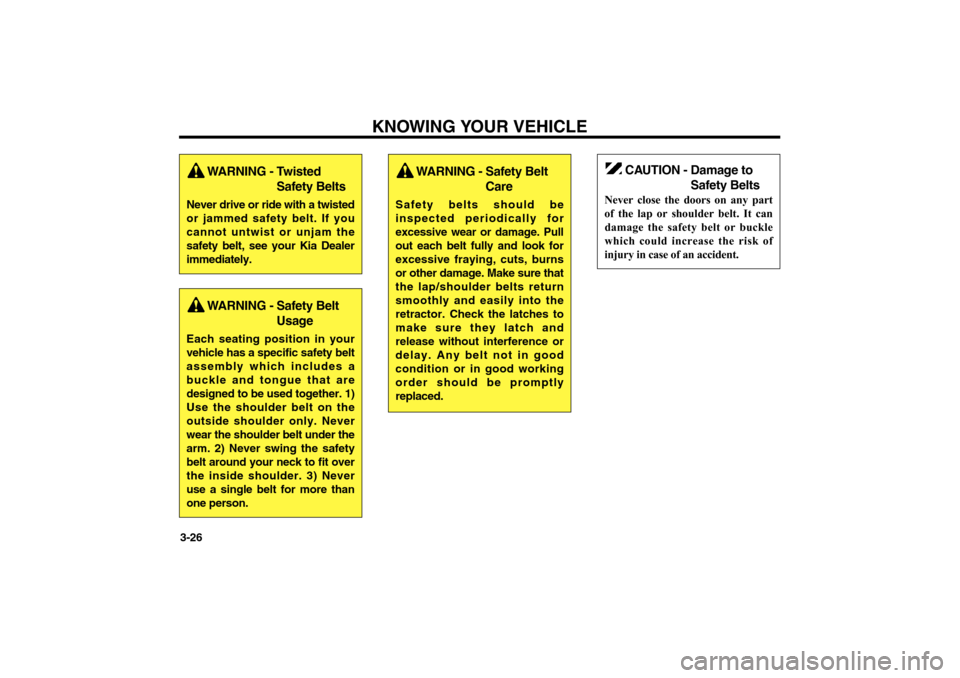
KNOWING YOUR VEHICLE
3-26
WARNING - Twisted
Safety Belts
Never drive or ride with a twisted
or jammed safety belt. If you
cannot untwist or unjam the
safety belt, see your Kia Dealer
immediately.
WARNING - Safety Belt
Usage
Each seating position in your
vehicle has a specific safety belt
assembly which includes a
buckle and tongue that are
designed to be used together. 1)
Use the shoulder belt on the
outside shoulder only. Never
wear the shoulder belt under the
arm. 2) Never swing the safety
belt around your neck to fit over
the inside shoulder. 3) Never
use a single belt for more than
one person.
WARNING - Safety Belt
Care
Safety belts should be
inspected periodically for
excessive wear or damage. Pull
out each belt fully and look for
excessive fraying, cuts, burns
or other damage. Make sure that
the lap/shoulder belts return
smoothly and easily into the
retractor. Check the latches to
make sure they latch and
release without interference or
delay. Any belt not in good
condition or in good working
order should be promptly
replaced.
CAUTION - Damage to
Safety Belts
Never close the doors on any part
of the lap or shoulder belt. It can
damage the safety belt or buckle
which could increase the risk of
injury in case of an accident.
MS-CNA-Eng 3.QXD 7/25/2005 5:17 PM Page 26
Page 36 of 225

3-27
RESTRAINT OF PREGNANT
WOMENPregnant women should wear lap/shoulder
belt assemblies whenever possible
according to specific recommendations by
their doctors. The lap portion of the belt
should be worn AS SNUGLY AND
LOW AS POSSIBLE.
RESTRAINT OF INFANTS
AND SMALL CHILDRENSmall children and infants should be
restrained by an approved child-restraint
system to help protect them while riding
in a vehicle.
Never allow a child to stand or kneel on
the seat of a moving vehicle. Never
allow a safety belt to be placed around
both a child and an adult or around two
children at the same time.
Children can be killed or injured by the
passenger air bag. The back seat is the
safest place for children 12 and under.Many companies manufacture child
restraint systems (often called child
seats) for infants and small children. An
acceptable child restraint system must
always satisfy the Safety Standards of
your country. Make sure that any child-
restraint system you use in your vehicle
is labeled as complying with those safety
standards.
The child-restraint system should be
chosen to fit both the size of the child
and the size of the vehicle seat. Be sure
to follow any instructions provided by
the child-restraint system manufacturer
when installing the child-restraint
system.
WARNING - Pregnant
Women
Pregnant women must never
place the lap portion of the
safety belt over the area of the
abdomen where the fetus is
located or above the abdomen.
WARNING - Children on
Laps
Never hold a child on your lap
or in your arms in a moving
vehicle.
Even a very strong person
cannot hold onto a child in the
event of even a minor collision.
MS-CNA-Eng 3.QXD 7/25/2005 5:17 PM Page 27
Page 37 of 225
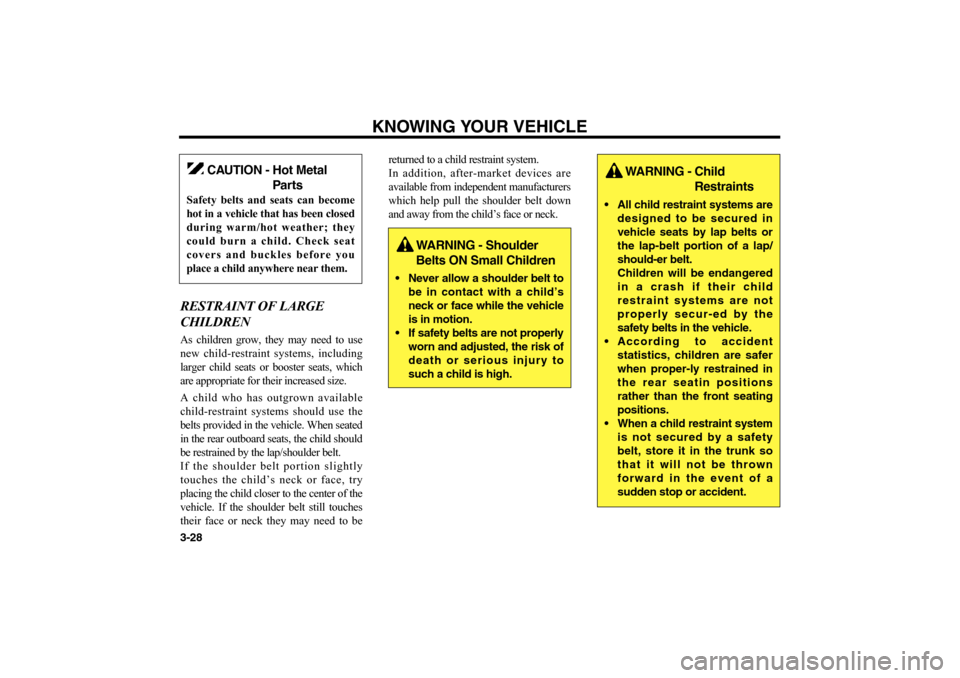
KNOWING YOUR VEHICLE
3-28RESTRAINT OF LARGE
CHILDRENAs children grow, they may need to use
new child-restraint systems, including
larger child seats or booster seats, which
are appropriate for their increased size.
A child who has outgrown available
child-restraint systems should use the
belts provided in the vehicle. When seated
in the rear outboard seats, the child should
be restrained by the lap/shoulder belt.
If the shoulder belt portion slightly
touches the child’s neck or face, try
placing the child closer to the center of the
vehicle. If the shoulder belt still touches
their face or neck they may need to bereturned to a child restraint system.
In addition, after-market devices are
available from independent manufacturers
which help pull the shoulder belt down
and away from the child’s face or neck.
CAUTION - Hot Metal
Parts
Safety belts and seats can become
hot in a vehicle that has been closed
during warm/hot weather; they
could burn a child. Check seat
covers and buckles before you
place a child anywhere near them.
WARNING - Shoulder
Belts ON Small Children
Never allow a shoulder belt to
be in contact with a child’s
neck or face while the vehicle
is in motion.
If safety belts are not properly
worn and adjusted, the risk of
death or serious injury to
such a child is high.
WARNING - Child
Restraints
All child restraint systems are
designed to be secured in
vehicle seats by lap belts or
the lap-belt portion of a lap/
should-er belt.
Children will be endangered
in a crash if their child
restraint systems are not
properly secur-ed by the
safety belts in the vehicle.
According to accident
statistics, children are safer
when proper-ly restrained in
the rear seatin positions
rather than the front seating
positions.
When a child restraint system
is not secured by a safety
belt, store it in the trunk so
that it will not be thrown
forward in the event of a
sudden stop or accident.
MS-CNA-Eng 3.QXD 7/25/2005 5:17 PM Page 28
Page 38 of 225
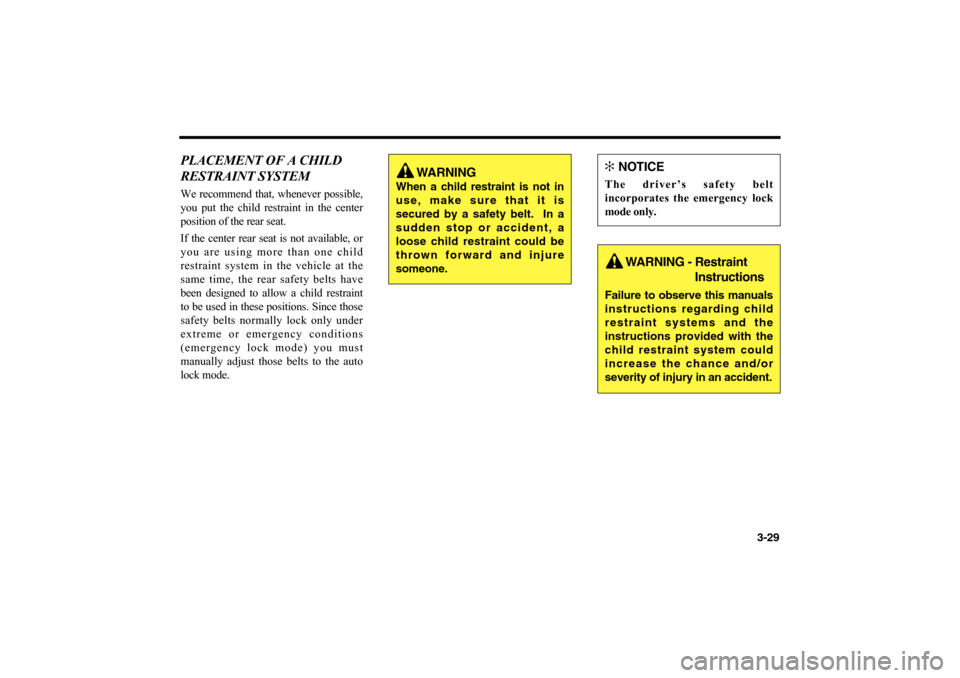
PLACEMENT OF A CHILD
RESTRAINT SYSTEMWe recommend that, whenever possible,
you put the child restraint in the center
position of the rear seat.
If the center rear seat is not available, or
you are using more than one child
restraint system in the vehicle at the
same time, the rear safety belts have
been designed to allow a child restraint
to be used in these positions. Since those
safety belts normally lock only under
extreme or emergency conditions
(emergency lock mode) you must
manually adjust those belts to the auto
lock mode.
3-29
WARNING
When a child restraint is not in
use, make sure that it is
secured by a safety belt. In a
sudden stop or accident, a
loose child restraint could be
thrown forward and injure
someone.
WARNING - Restraint
Instructions
Failure to observe this manuals
instructions regarding child
restraint systems and the
instructions provided with the
child restraint system could
increase the chance and/or
severity of injury in an accident.✻
NOTICE
The driver’s safety belt
incorporates the emergency lock
mode only.
MS-CNA-Eng 3.QXD 7/25/2005 5:17 PM Page 29
Page 39 of 225
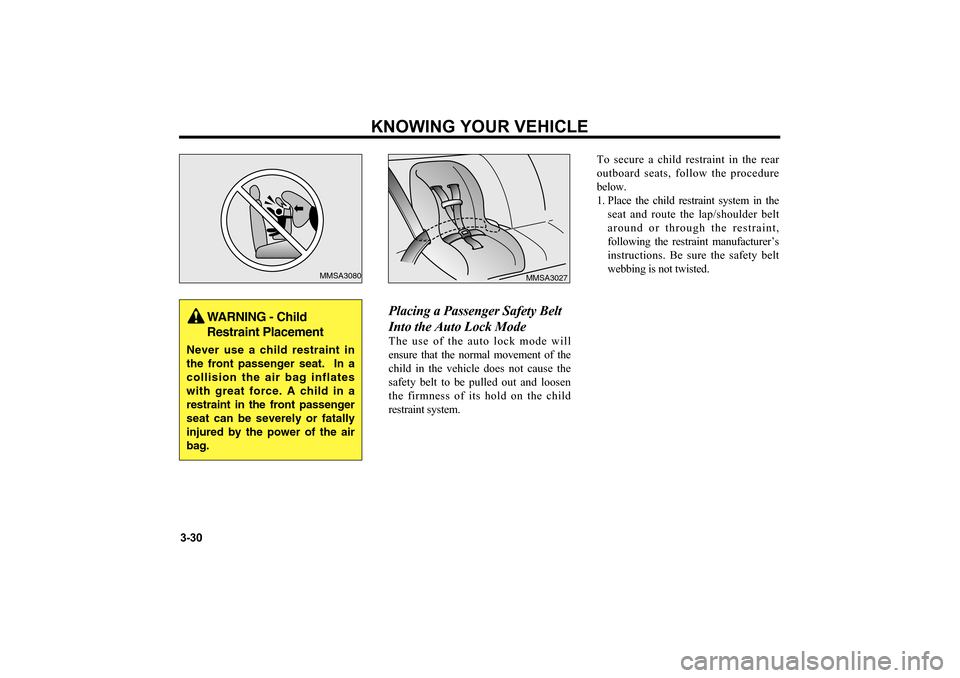
Placing a Passenger Safety Belt
Into the Auto Lock ModeThe use of the auto lock mode will
ensure that the normal movement of the
child in the vehicle does not cause the
safety belt to be pulled out and loosen
the firmness of its hold on the child
restraint system.To secure a child restraint in the rear
outboard seats, follow the procedure
below.
1. Place the child restraint system in the
seat and route the lap/shoulder belt
around or through the restraint,
following the restraint manufacturer’s
instructions. Be sure the safety belt
webbing is not twisted.
KNOWING YOUR VEHICLE
3-30
MMSA3080
MMSA3027
WARNING - Child
Restraint Placement
Never use a child restraint in
the front passenger seat. In a
collision the air bag inflates
with great force. A child in a
restraint in the front passenger
seat can be severely or fatally
injured by the power of the air
bag.
MS-CNA-Eng 3.QXD 7/25/2005 5:17 PM Page 30
Page 40 of 225
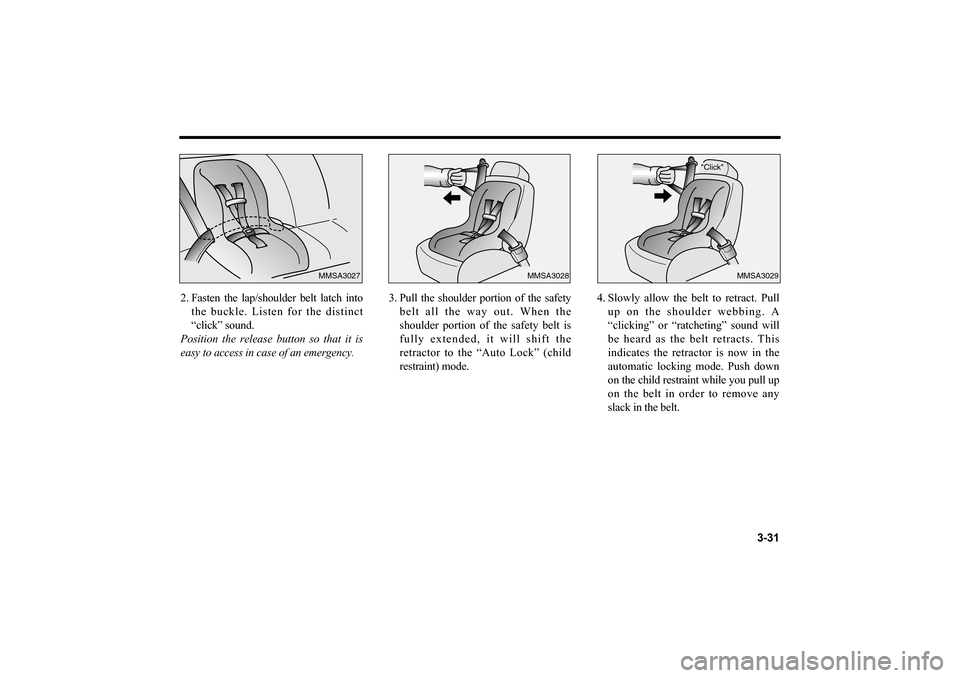
2. Fasten the lap/shoulder belt latch into
the buckle. Listen for the distinct
“click” sound.
Position the release button so that it is
easy to access in case of an emergency.3. Pull the shoulder portion of the safety
belt all the way out. When the
shoulder portion of the safety belt is
fully extended, it will shift the
retractor to the “Auto Lock” (child
restraint) mode.4. Slowly allow the belt to retract. Pull
up on the shoulder webbing. A
“clicking” or “ratcheting” sound will
be heard as the belt retracts. This
indicates the retractor is now in the
automatic locking mode. Push down
on the child restraint while you pull up
on the belt in order to remove any
slack in the belt.
3-31
MMSA3028
MMSA3027
"Click"
MMSA3029
MS-CNA-Eng 3.QXD 7/25/2005 5:17 PM Page 31